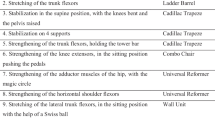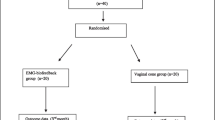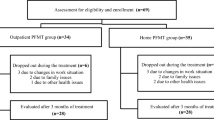Abstract
Introduction and hypothesis
The primary objective was to compare high- and low-frequency pelvic floor muscle training (PFMT) with the impact on urinary incontinence episode frequency over 1 week (IEF/week). The secondary objective was to compare the two groups with regard to pelvic floor muscle function, morphometry, incontinence quality of life, and patient global impression.
Methods
This was a randomised parallel controlled study. The setting was regional gynaecological and urological outpatient clinics. The subjects consisted of a sample of 86 women with stress urinary incontinence (SUI). Group A underwent high-frequency PFMT and group B underwent low-frequency PFMT for 12 weeks. We recorded the IEF/week. The International Consultation on Incontinence Questionnaire Urinary Incontinence Short Form (ICIQ-UI SF) was used. Pelvic floor muscle function was evaluated using a perineometer. Pelvic floor muscle morphometry was evaluated with 3D/4D ultrasound. The Urinary Incontinence Quality of Life Scale (I-QoL) was used.
Results
Significant differences between group A and B after treatment (p<0.001) were noted in favour of group A in IEF/week (group A 10.2±7.0/2.3±3.0 vs group B 9.3±4.7/6.3±4.9), in the ICIQ-UI SF (group A 9.7±3.0/3.7 ± 3.6 vs group B 9.9±3.2/9.4±3.4). Significant differences between groups A and B after treatment were noted in favour of group A for pelvic floor muscle function in terms of maximal voluntary contraction and its duration, and also for pelvic floor muscle morphometry in terms of a reduction of the hiatal area during rest, contraction, and the Valsalva manoeuvre.
Conclusions
High-frequency PFMT for 12 weeks significantly decreased IEF/week in comparison with low-frequency PFMT. In the high-frequency exercise group, women had significantly better pelvic floor muscle function, morphometry and quality of life than the low-frequency exercise group.




Similar content being viewed by others
References
Abrams P, Andersson KE, Apostolidis A, et al. 6th International Consultation on Incontinence. Recommendations of the International Scientific Committee: evaluation and treatment of urinary incontinence, pelvic organ prolapse and faecal incontinence. Neurourol Urodyn. 2018;37(7):2271–2.
Bo K, Frawley HC, Haylen BT, Abramov Y, Almeida FG, Berghmans B, et al. An International Urogynecological Association (IUGA)/International Continence Society (ICS) joint report on the terminology for the conservative and nonpharmacological management of female pelvic floor dysfunction. Neurourol Urodyn. 2017;36(2):221–44.
Bo K, Berghmans B, Morkved S, Van Kampen M. Evidence–based physical therapy for the pelvic floor, 2nd Edition. London: Churchill Livingstone, 2015. p. 446.
Haylen BT, de Ridder D, Freeman RM, et al. An International Urogynecological Association (IUGA)/International Continence Society (ICS) joint report on the terminology for female pelvic floor dysfunction. Int Urogynecol J. 2010;21(1):5–26.
Kim EY, Kim SY, Oh DW. Pelvic floor muscle exercises utilizing trunk stabilization for treating postpartum urinary incontinence: randomized controlled pilot trial of supervised versus unsupervised training. Clin Rehabil. 2012;26(2):132–41.
Szumilewicz A, Dornowski M, Piernicka M, et al. High-low impact exercise program including pelvic floor muscle exercises improves pelvic floor muscle function in healthy pregnant women—a randomized control trial. Front Physiol. 2019;9:1867.
Szumilewicz A, Kuchta A, Kranich M, Dornowski M, Jastrzębski Z. Prenatal high-low impact exercise program supported by pelvic floor muscle education and training decreases the life impact of postnatal urinary incontinence: a quasiexperimental trial. Medicine (Baltimore). 2020;99(6):e18874.
Cacciari LP, Morin M, Mayrand MH, Tousignant M, Abrahamowicz M, Dumoulin C. Pelvic floor morphometrical and functional changes immediately after pelvic floor muscle training and at 1-year follow-up, in older incontinent women. Neurourol Urodyn. 2021;40(1):245–55.
Cyr MP, Dumoulin C, Bessette P, et al. Characterizing pelvic floor muscle function and morphometry in survivors of gynecological cancer who have dyspareunia: a comparative cross-sectional study. Phys Ther. 2021;101(4):pzab042.
Dietz HP, Shek C, Clarke B. Biometry of the pubovisceral muscle and levator hiatus by 3D pelvic floor ultrasound. Ultrasound Obstet Gynecol. 2005;25:580–5.
Dietz HP, Wong V, Shek KL. Simplified method for determining hiatal biometry. Aust NZ J Obstet Gynecol. 2011;51:540–3.
Dietz HP. Ultrasound imaging of the pelvic floor. I. Two-dimensional aspects. Ultrasound Obstet Gynecol. 2004;23:80–92.
Cyr MP, Kruger J, Wong V, Dumoulin C, Girard I, Morin M. Pelvic floor morphometry and function in women with and without puborectalis avulsion in the early postpartum period. Am J Obstet Gynecol. 2017;216(3):274.e1–8.
Fontaine F, Dumoulin C, Bergeron S, et al. Pelvic floor muscle morphometry and function in women with primary and secondary provoked vestibulodynia. J Sex Med. 2018;15(8):1149–57.
Avery K, Donovan J, Peters TJ, Shaw C, Gotoh M, Abrams P. ICIQ: A brief and robust measure for evaluating the symptoms and impact of urinary incontinence. Neurourol Urodyn. 2004;23:322–30.
Klovning A, Avery K, Sandvik H, Hunskaar S. Comparison of two questionnaires for assessing the severity of urinary incontinence: the ICIQ-UI SF versus the incontinence severity index. Neurourol Urodyn. 2009;28(5):411–5.
Coyne K, Revicki D, Hunt T, et al. Psychometric validation of an overactive bladder symptom and health-related quality of life questionnaire: the OAB-q. Qual Life Res. 2002;11(6):563–74.
Coyne KS, Payne C, Bhattacharyya SK, Revicki DA, Thompson C, Corey R, et al. The impact of urinary urgency and frequency on health related quality of life in overactive bladder: results from a national community survey. Value Health. 2004;7:455–63.
Rahmani N, Mohseni-Bandpei MA. Application of perineometer in the assessment of pelvic floor muscle strength and endurance: a reliability study. J Bodyw Mov Ther. 2011;15:209–14.
Laycock J, Jerwood D. Pelvic floor assessment: the P.E.R.F.E.C.T. scheme. Physiotherapy. 2001;87(1):631.
Bushnell DM, Martin ML, Summers KH, Svihra J, Lionis C, Patrick DL. Quality of life of women with urinary incontinence: cross-cultural performance of 15 language versions of the I-QOL. Qual Life Res. 2005;14:1901–13.
Yalcin I, Bump RC. Validation of two global impression questionnaires for incontinence. Am J Obstet Gynecol. 2003;189(1):98–101.
Cohen J. Statistical power analysis for the behavioural sciences. Hillsdale: Lawrence Erlbaum Associates. 1998
Bø K, Hilde G, Tennfjord MK, Stær-Jensen J, Siafarikas F, Ellstrøm EM. Pelvic floor muscle variables and levator hiatus dimensions: a 3/4D transperineal ultrasound cross-sectional study on 300 nulliparous pregnant women. Int Urogynecol J. 2014;25:1357–61.
Albrich S, Steetskamp J, Knoechel SL, Porta S, Hoffmann G, Skala C. Assessment of pelvic floor muscle contractility: digital palpation versus 2D and 3D perineal ultrasound. Arch Gynecol Obstet. 2016;293:4.
Acknowledgements
The authors are grateful to all patients who participated in this study.
Author information
Authors and Affiliations
Contributions
P.U. is responsible for the provision and selection of suitable probands; J.S. and M.H. are responsible for study design and methodology; M.H. is responsible for data collection and intervention; E.V. is responsible for preparing educational materials for exercise; P.U., J.S. and M.H. have access to the final trial dataset. M.H. paid for English corrections. All authors have read and approved the final manuscript.
Corresponding author
Ethics declarations
Ethics approval
The protocol was approved by the Ethics Committee of the self-governing region with the number 3545/2020/ODDZ-06621 on 28 February 2020.
All participants gave written informed consent before data collection began.
Conflicts of interest
The authors have no conflicts of interest to declare.
Source(s) of support: VEGA 1/0540/21
Correlation of a combination of biochemical and clinical markers in the diagnosis and prognosis of the clinical outcome of cancer.
Additional information
Publisher’s note
Springer Nature remains neutral with regard to jurisdictional claims in published maps and institutional affiliations.
Registration: NCT04340323
Rights and permissions
Springer Nature or its licensor (e.g. a society or other partner) holds exclusive rights to this article under a publishing agreement with the author(s) or other rightsholder(s); author self-archiving of the accepted manuscript version of this article is solely governed by the terms of such publishing agreement and applicable law.
About this article
Cite this article
Hagovská, M., Švihra, J., Urdzík, P. et al. A randomised interventional parallel study to evaluate the effect of different frequencies of pelvic floor muscle exercises with core stabilisation using three-dimensional ultrasound: the PELSTAB study. Int Urogynecol J 34, 2049–2060 (2023). https://doi.org/10.1007/s00192-023-05473-w
Received:
Accepted:
Published:
Issue Date:
DOI: https://doi.org/10.1007/s00192-023-05473-w




